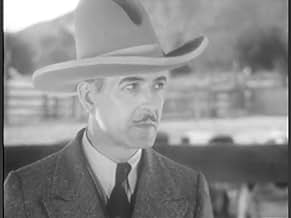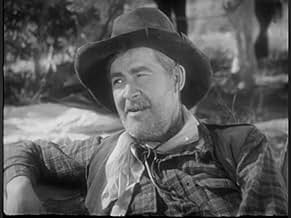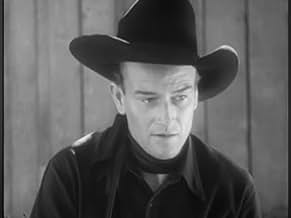Agrega una trama en tu idiomaTed Hayden impersonates a wanted man and joins Gentry's gang only to learn later that Gentry was the one who killed his father. He saves Virginia Winters' dad's ranch from Gentry and also re... Leer todoTed Hayden impersonates a wanted man and joins Gentry's gang only to learn later that Gentry was the one who killed his father. He saves Virginia Winters' dad's ranch from Gentry and also rescues his long-lost brother Spud.Ted Hayden impersonates a wanted man and joins Gentry's gang only to learn later that Gentry was the one who killed his father. He saves Virginia Winters' dad's ranch from Gentry and also rescues his long-lost brother Spud.
- Dirección
- Guionistas
- Elenco
- Fay Winters
- (as Virginia Faire Brown)
- Dusty Rhodes
- (as George Hayes)
- Mr. Gentry
- (as Loyd Whitlock)
- Spud Hayden
- (as Billie O'Brien)
- Cattle Buyer Hornsby
- (sin créditos)
- Doctor Silsby
- (sin créditos)
- Henchman
- (sin créditos)
- Henchman
- (sin créditos)
- Henchman
- (sin créditos)
- Henchman
- (sin créditos)
- Henchman Butch
- (sin créditos)
- Dirección
- Guionistas
- Todo el elenco y el equipo
- Producción, taquilla y más en IMDbPro
Opiniones destacadas
And then there is the young John Wayne. I think it is during this period in his career that he proved himself to be the giant star he became. When he dons white buckskin in "The Telegraph Trail," he becomes almost otherworldly. Here he plays a man posing as an outlaw to find the killer of his father. By the time he has set things right, lying supine in his long-lost brother's arms, you understand why so many moviegoers couldn't get enough of him. His entire body in that moment gives way to the scene, and you cherish how tenderly and passionately he's willing to play his part. This movie taps into that well of memories some of us have with family and loved ones, and as Father's Day is tomorrow, it helps remind me what deep, elemental emotion men often feel that these days goes unacknowledged. I certainly wasn't aware of it in those days with my grandfather; but I've gained a new consciousness that has come with my being about his age at the time and watching things I know he'd have loved. Like "The West Divide." It makes you wish they made more westerns like this one.
Young John Wayne and grizzled George Hayes start with what I learned in college theater-history classes was called a "feather-duster" scene, where characters -- such as a maid, with a feather-duster -- tell the background of the story, today called "the back story."
It's kinda corny, but isn't too damaging.
Probably even in 1934 what was about to happen was predictable, but, before that predictable ending, enough happens in between it should hold the viewer's interest. It held mine.
When the hero meets the leading lady, there is no poor-writing instant romance. In fact, there is no real contact. It's an unusual boy-meets-girl.
That girl is Virginia Faire Brown, who is shown with 74 credits, although she never rose to be a major player and certainly not a star. But she is very attractive, even elegant, with an unusual dark-haired beauty.
Her character's father is played by the veteran Lafe McKee. The sheriff is by that veteran, and very talented actor, who didn't, alas, often enough get to show just how good an actor he was, Earl Dwire.
Chief bad guy is played by "Loyd Whitlock," who is usually known as Lloyd Whitlock, a very busy man with more than 200 credits!
OK, good story, great cast ably performing, lots of riding scenes, and a no-music-track realism that should keep you pinned to your seat. And if you want to see it, there's a good print at YouTube.
This is a fairly acceptable entry in John Wayne's Lone Star series of films made in the early to mid-thirties. There is quite a diverting storyline, even though the acting is as creaky as usual for these flicks. It's the stunts that stand out in all of the low budget efforts Wayne made in those days, and their success is thanks to stuntman extraordinaire Yakima Canutt. You get the impression as you watch that some real hair-raising risks were taken to capture these scenes and you sometimes wonder whether it was worth it considering the poor quality of most other aspects of the films. Watch out for Canutt standing in for bad guy Lloyd Whitlock, who sports a full head of greying hair, in the fight with Wayne near the end of the film. Canutt had dark hair and a noticeable bald patch, but hack director R. N. Bradbury obviously didn't believe in going to the expense of making even a perfunctory effort to disguise the actors' physical differences. Oddly enough, it's this kind of lack of attention to detail that make the Lone Star films so curiously endearing.
The film opens with a piece of good luck coming their way in the person of the dying gunman Gatt Ganns who's been hired by Lloyd Whitlock to kill rancher Lafe McKee. Of course Whitlock is once again a villain in the Snidely Whiplash tradition who not only wants the ranch, but also has evil designs on McKee's daughter Virginia Brown Faire.
In reviewing B westerns, sometimes I have a tendency to reach back to those 19th century morality plays so popular in that era. Whitlock in fact even laughs like a villain in one of those plays. For reference you should see the Irene Dunne-Allan Jones version of Showboat to see just the kind of drama they used to put on then. It survived in the B western, John Wayne's as well as other's.
Wayne of course by the end solves all the problems concerned and the villain gets his just desserts. We can't say how though.
The Duke pretends to be the recently deceased Mr. Ganns to get the goods on the bad guys along with sidekick Gabby Hayes. He discovers a young kid being raised by one of the outlaws. Interesting in this B western set firmly in the 19th century morality play tradition, we also have a topic so very gingerly touched on as child abuse. A rather adult theme for a western or any kind of picture at that time.
Wayne was just beginning his stay at Monogram Pictures Lone Star westerns, this was his third. Monogram had a stock company to rival the much better one of John Ford. Note how for the next three or four years, the casts are just about the same in every Wayne western at that studio. It gets hard to keep these in chronological order, I wouldn't be surprised if a few of these weren't shot simultaneously.
The best you can say about the Monogram films is that they kept John Wayne employed, not something easily said during the Depression. And they beat those serials he did for Mascot. West of the Divide will never be on any John Wayne fans top 10 list.
¿Sabías que…?
- TriviaIn 1934, this film was condemned by the Catholic Legion of Decency.
- ErroresDuring a fight between Ted Hayden and Butch, Spuds shouts, "Come on, Ted!" Actually, Ted has been introduced to him and all others at the gangsters' hide-out as Gat Ganns. His real identity is in fact revealed later.
- Citas
Doctor Silsby: You got her here just in time. A small artery's been severed. However, I don't think it's very serious.
- Versiones alternativasFox/Lorber Associates, Inc. and Classics Associates, Inc. copyrighted a version in 1985 with a new original score composed and orchestrated by William Barber. It was distributed by Fox/Lorber and ran 48 minutes.
- ConexionesEdited into Six Gun Theater: West of the Divide (2016)
Selecciones populares
- How long is West of the Divide?Con tecnología de Alexa
Detalles
- Tiempo de ejecución54 minutos
- Color
- Mezcla de sonido
- Relación de aspecto
- 1.37 : 1
Contribuir a esta página

































